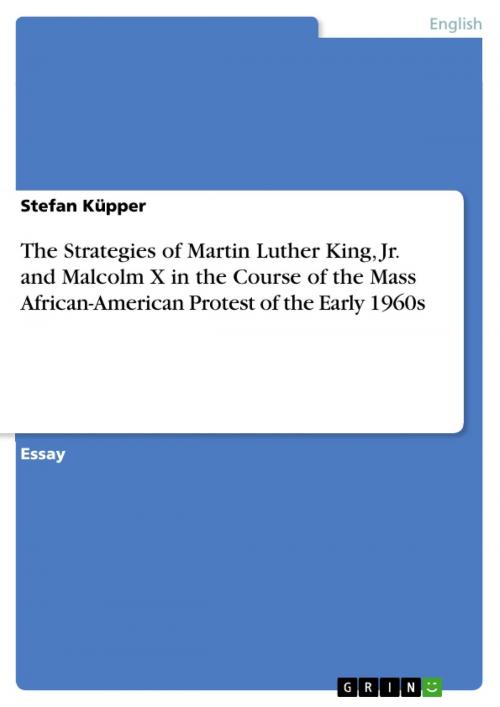The Strategies of Martin Luther King, Jr. and Malcolm X in the Course of the Mass African-American Protest of the Early 1960s
Nonfiction, Entertainment, Drama, Anthologies| Author: | Stefan Küpper | ISBN: | 9783640568727 |
| Publisher: | GRIN Publishing | Publication: | March 19, 2010 |
| Imprint: | GRIN Publishing | Language: | English |
| Author: | Stefan Küpper |
| ISBN: | 9783640568727 |
| Publisher: | GRIN Publishing |
| Publication: | March 19, 2010 |
| Imprint: | GRIN Publishing |
| Language: | English |
Essay from the year 2008 in the subject American Studies - Culture and Applied Geography, grade: 2,0, University of Reading (Department of History), language: English, abstract: In 1966, Martin Luther King, Jr. still held the opinion that violent resistance to white supremacy would be futile. But at this time a certain group of people, especially young blacks in the northern cities, turned towards a strategy of armed resistance which was spread by radical black nationalists like Malcolm X. Beginning shortly after the Second World War, when the hopes of most African Americans for racial equality were not fulfilled, and on its peak at the end of the 1950s, an increasing number of blacks protested peacefully against discrimination. The National Association for the Advancement of Colored People (NAACP) and leading figures like MLK helped to organize several demonstrations, sit-ins (Greensboro lunch counter sit-in, 1960) and boycotts (Montgomery Bus Boycott, 1955), aiming at full integration of black Americans. At the same time, but evidently opposing these nonviolent forms of protest, the Nation of Islam (NoI), amongst them Malcolm X, demanded a new kind of Black Nationalism which emphasized black pride, unity and self-respect. Nevertheless, these pragmatic radicals aimed at separatism, but the vehicle to achieve it was supposed to be a revolution. These two antagonistic approaches determined the Civil Rights Movement from the mid 1950s onward.
Essay from the year 2008 in the subject American Studies - Culture and Applied Geography, grade: 2,0, University of Reading (Department of History), language: English, abstract: In 1966, Martin Luther King, Jr. still held the opinion that violent resistance to white supremacy would be futile. But at this time a certain group of people, especially young blacks in the northern cities, turned towards a strategy of armed resistance which was spread by radical black nationalists like Malcolm X. Beginning shortly after the Second World War, when the hopes of most African Americans for racial equality were not fulfilled, and on its peak at the end of the 1950s, an increasing number of blacks protested peacefully against discrimination. The National Association for the Advancement of Colored People (NAACP) and leading figures like MLK helped to organize several demonstrations, sit-ins (Greensboro lunch counter sit-in, 1960) and boycotts (Montgomery Bus Boycott, 1955), aiming at full integration of black Americans. At the same time, but evidently opposing these nonviolent forms of protest, the Nation of Islam (NoI), amongst them Malcolm X, demanded a new kind of Black Nationalism which emphasized black pride, unity and self-respect. Nevertheless, these pragmatic radicals aimed at separatism, but the vehicle to achieve it was supposed to be a revolution. These two antagonistic approaches determined the Civil Rights Movement from the mid 1950s onward.















